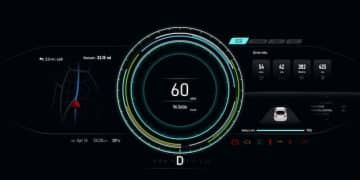2025 Federal Tax Credits: How They’ll Impact EV Adoption in the US

The updated 2025 federal tax credits for electric vehicles (EVs) aim to boost adoption rates nationwide by making EVs more affordable through significant financial incentives, while also encouraging domestic manufacturing and supply chains.
Are you wondering how will the updated 2025 federal tax credits impact electric vehicle adoption rates nationwide? The new incentives are designed to help more Americans switch to electric vehicles, offering significant savings and promoting a greener future.
Understanding the 2025 Federal EV Tax Credit Updates
The federal tax credit for electric vehicles has undergone significant changes heading into 2025. These updates are intended to refine the incentives, making them more effective and accessible to a wider range of consumers.
Let’s delve into the key elements of these tax credit revisions.
Key Changes to the Tax Credit
Several modifications have been introduced to the EV tax credit, impacting eligibility and the amount of credit received.
- Income Limits: Adjusted gross income (AGI) limits are now firmly in place to ensure the credit benefits those who need it most.
- Vehicle Price Caps: There are maximum MSRP (Manufacturer’s Suggested Retail Price) limits for qualifying vehicles.
- Battery Sourcing: Stricter requirements for battery components and critical mineral sourcing are designed to bolster domestic manufacturing.
Impact on Consumers
The updated tax credit is designed to directly benefit consumers by lowering the upfront cost of purchasing an EV. This also indirectly benefits the economy as a whole by stimulating manufacturing. Some consumers may find some confusion in the red tape, however.

In summary, the 2025 federal EV tax credit updates aim to incentivize EV adoption by targeting affordability, supporting domestic manufacturing, and ensuring the benefits reach a broader range of consumers.
Eligibility Requirements for the 2025 EV Tax Credit
To qualify for the 2025 EV tax credit, both the vehicle and the buyer must meet specific criteria. Understanding these requirements is crucial for determining eligibility and maximizing potential savings.
Here’s a detailed breakdown of the key factors.
Vehicle Requirements
Several requirements must be met by the vehicle to qualify.
- Manufacturing Location: The EV must undergo final assembly in North America.
- Battery Components and Minerals: A certain percentage of the battery components and critical minerals must be sourced from the US or its free trade partners.
- Vehicle Type: The credit is available for new EVs, including battery electric vehicles (BEVs) and plug-in hybrid electric vehicles (PHEVs).
Buyer Requirements
Individual buyers also need to satisfy certain conditions to be eligible for the tax credit.
- Income Limits: The buyer’s modified adjusted gross income (MAGI) must be below a certain threshold. For those married filing jointly, the limit is $300,000; for heads of households, it’s $225,000; and for single filers, it is $150,000.
- Tax Liability: The tax credit can only be used to reduce your tax liability to $0; it is non-refundable.
Meeting both the vehicle and buyer requirements is essential for claiming the 2025 EV tax credit. Reviewing these criteria carefully can help ensure you’re eligible for the incentives when purchasing an electric vehicle.
The Impact of Income Limits and Vehicle Price Caps
The introduction of income limits and vehicle price caps in the 2025 EV tax credit aims to refine the distribution of incentives, ensuring they benefit a broader range of consumers and promote affordability.
Let’s examine how these measures impact different segments of the market.
How Income Limits Affect Access to the Credit
Income limits are designed to target the tax credit towards middle- and lower-income individuals and families who are more likely to be sensitive to the upfront cost of an EV.
By setting income thresholds, the government ensures that the benefits are directed towards those who need them most, thereby increasing the accessibility of electric vehicles for a larger portion of the population. Those above the income limits are not eligible to claim the credit.
The Role of Vehicle Price Caps
The vehicle price caps prevent the tax credit from being used to subsidize luxury EVs, focusing instead on more affordable models.
These price limits encourage manufacturers to produce and offer a wider range of reasonably priced electric vehicles, catering to the mass market and accelerating the transition to electric mobility. Sedans, for example, have a price cap of $55,000. SUVs and trucks have a price cap of $80,000.

In conclusion, the implementation of income limits and vehicle price caps aims to make the EV tax credit more equitable and effective, directing incentives towards those who need them most and promoting the production of affordable electric vehicles.
Domestic Manufacturing and Battery Sourcing Requirements
The 2025 federal EV tax credit places a strong emphasis on domestic manufacturing and responsible battery sourcing, aiming to bolster the U.S. economy and create a more secure and sustainable supply chain.
Here’s a closer look at these critical requirements.
Benefits of Domestic Manufacturing
The requirement for final assembly in North America is intended to stimulate job creation and economic growth within the United States.
- Job Creation: Encourages automakers to invest in U.S.-based manufacturing facilities, leading to new employment opportunities.
- Economic Growth: Boosts local economies by increasing production and supporting related industries.
- Supply Chain Security: Reduces reliance on foreign supply chains, enhancing the resilience of the U.S. automotive industry.
Importance of Responsible Battery Sourcing
The sourcing requirements for battery components and critical minerals aim to promote environmentally and socially responsible practices.
- Environmental Protection: Encourages sustainable mining and processing of critical minerals, reducing the environmental impact of battery production.
- Human Rights: Ensures that minerals are sourced ethically, avoiding forced labor and other human rights abuses.
- Supply Chain Diversification: Promotes the development of diverse and reliable supply chains for battery materials.
In summary, the domestic manufacturing and responsible battery sourcing requirements of the 2025 EV tax credit are designed to create a more robust, sustainable, and ethical electric vehicle industry within the United States, benefiting both the economy and the environment.
Potential Challenges and Criticisms of the Updated Tax Credits
While the updated 2025 federal EV tax credits aim to accelerate electric vehicle adoption, they also face potential challenges and criticisms that could impact their effectiveness.
Let’s explore some of these concerns.
Supply Chain Constraints
Meeting the domestic manufacturing and battery sourcing requirements may prove difficult due to existing supply chain constraints.
Automakers are navigating complexities in securing the necessary materials and components from compliant sources, which could limit the availability of EVs that qualify for the tax credit. This could slow down the pace of EV adoption and make it more difficult for consumers to take advantage of the incentives.
Consumer Awareness and Understanding
The complexity of the eligibility requirements can confuse consumers and create barriers to accessing the tax credit.
Many potential EV buyers may be unsure about the specific criteria for vehicles and income limits, leading to missed opportunities or frustration. Clear and accessible information is essential to ensure consumers can easily navigate the process and make informed decisions.
In conclusion, while the updated 2025 EV tax credits hold considerable promise, addressing potential challenges and criticisms is essential to maximize their impact and ensure a successful transition to electric mobility.
Strategies for Maximizing the 2025 EV Tax Credit
To fully benefit from the 2025 federal EV tax credit, consumers should adopt specific strategies to ensure they meet all eligibility requirements and maximize their savings.
Here are some practical tips to guide potential EV buyers.
Researching Eligible Vehicles
Before making a purchase, thoroughly research which EV models qualify for the tax credit.
Consult the IRS website and other reliable sources to verify that the vehicle meets the domestic manufacturing and battery sourcing requirements. Additionally, be aware of any price caps that may apply to different vehicle types, and also be wary of rebates, depending on the state.
Planning Your Purchase
Consider carefully when to make your EV purchase to take advantage of the tax credit.
- Year-End Planning: Evaluate your tax situation at the end of the year to determine whether you will have sufficient tax liability to claim the full credit.
- Timing Your Purchase: If possible, time your purchase to coincide with potential changes or updates to the tax credit program.
- Consult a Tax Professional: Seek advice from a qualified tax professional to ensure that you meet all eligibility requirements and to optimize your tax planning.
By following these strategies, consumers can maximize their chances of claiming the 2025 EV tax credit and enjoy the benefits of electric vehicle ownership while contributing to a greener future.
| Key Point | Brief Description |
|---|---|
| 💰 Income Limits | MAGI must be below $150k (single), $225k (HOH), or $300k (joint). |
| 🚗 Vehicle Price Caps | Sedans max at $55k; SUVs and trucks at $80k. |
| 🔋 Battery Sourcing | Components and minerals must be U.S. or free-trade sourced. |
| 🌎 Final Assembly | EV must undergo final assembly in North America. |
Frequently Asked Questions
▼
For those married filing jointly, the limit is $300,000; for heads of households, it’s $225,000; and for single filers, it is $150,000 – a way to make sure the biggest credits are going to those who need them most.
▼
Yes, vehicle price caps are in place for eligible EVs: sedans have a limit of $55,000, while SUVs, trucks, and vans can be priced up to $80,000 in order to qualify for the credit.
▼
To qualify for the 2025 EV tax credit, the electric vehicle must undergo final assembly in North America, boosting local economies and supply chains based in the United States.
▼
A certain percentage of the battery components and critical minerals must be sourced from the US or its free trade partners to ensure responsible and ethical sourcing, and encourage investment.
▼
The EV tax credit can be applied to leased vehicles, but it’s usually claimed by the leasing company, which may pass the savings on to the consumer through lower monthly payments.
Conclusion
The updated 2025 federal tax credits represent a significant step toward accelerating electric vehicle adoption across the United States. By understanding the eligibility requirements, potential challenges, and available strategies, consumers can make informed decisions and contribute to a greener, more sustainable future. The focus on domestic manufacturing and battery sourcing not only supports U.S. economic growth but also promotes responsible and ethical practices in the EV industry.





